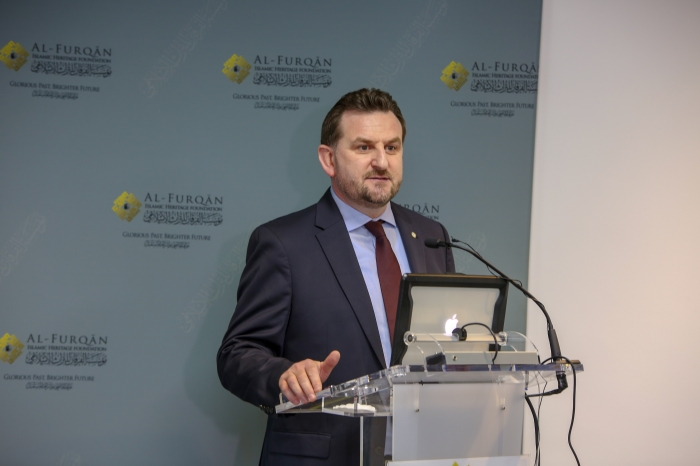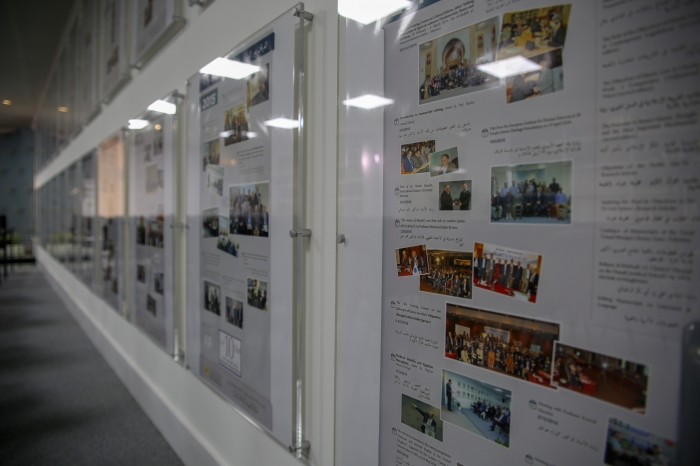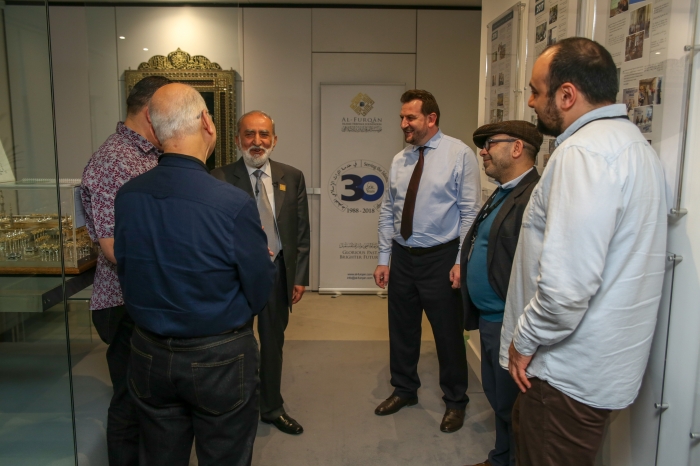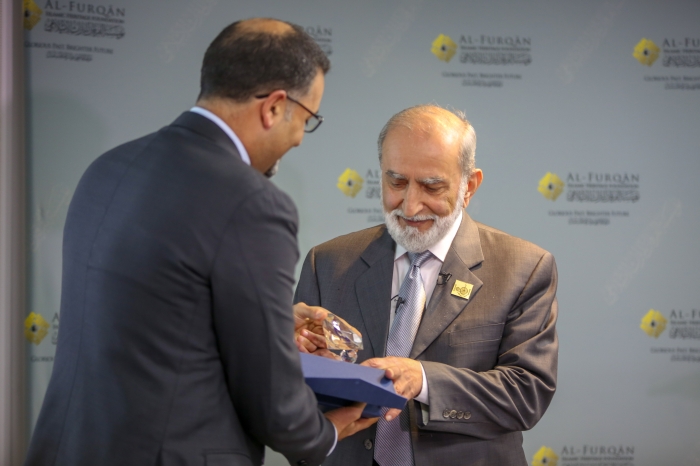“Women of Science, Medicine and Management in Muslim Civilisation”, by Prof. Salim Al-Hassani
As part of its seasonal lecture series, Al-Furqān Islamic Heritage Foundation organised a public lecture on Wednesday, 27 February 2019. The lecture was titled “Women of Science, Medicine and Management in Muslim Civilisation”, and was hosted at the lecture theatre in Al-Furqān’s London headquarters. The lecturer was Professor Salim Al-Hassani, Emeritus Professor of Mechanical Engineering and Professorial Fellow in Humanities at the University of Manchester.
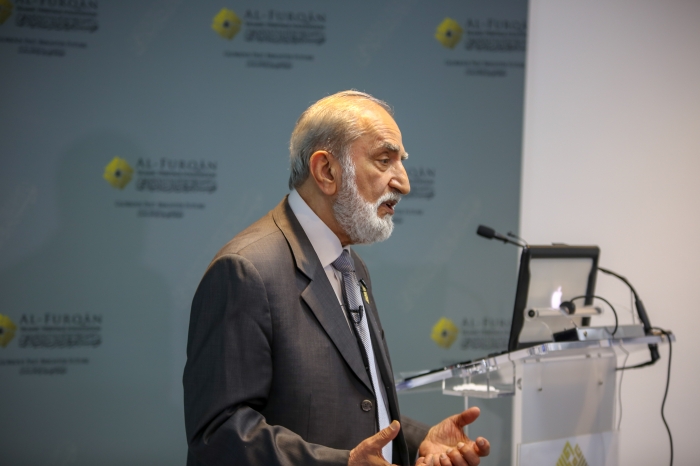
Mr Sali Shahsivari, the Managing Director of Al-Furqan, opened the evening by welcoming and thanking the guests, before inviting Mr Sharaf Yamani, Member of the Board of Directors of Al-Furqan, to deliver some opening remarks.
Mr Yamani began by extending a warm welcome from the Chairman of the Foundation, Sheikh Ahmed Zaki Yamani. He then went to assert that the role of women in the history of Islamic civilisation is a “pride” and that the Foundation has played a role in contributing to the scholarship and furthering the horizons of research with respect to this marvellous, albeit sensitive - at times - topic. These manifest in the publication of some works, including Sheikh Ahmed Zaki Yamani’s The House of Khadijah bint Khuwaylid in Makkah al-Mukarramah: A Historical Study of Its Location, Building and Architecture. Additionally, Sheikh Ahmad Zaki Yamani himself authored another book titled Woman in Islam, wherein one finds a concise but detailed portrayal of the societal position accorded to women in Islamic law and practice. Only in the last few weeks, the Foundation has published Ijāzat ʾulamāʿ wa ʾālimāt al-haramayn al-sharīfayn lī ʾulamāʿ al-amṣār (The Diplomas and Certificates of the Male and Female Scholars of Makkah and Madinah throughout History); a book that lists around one thousand such female scholars. Indeed, in Mr Sharaf Yamani’s words, “If ever you were inspired or motivated by any man in the history of the Islamic civilisation, you can make the assumption and know that these men were probably influenced by a woman.”
Following Mr Yamani’s opening comments, Mr Shahsivari gave some words of introduction regarding the guest speaker and the subject of the evening. Undoubtedly, there is growing concerning and a plethora of misconceptions regarding gender and women in society, and particularly in relation to Islam. This would prove to be an interesting topic to tackle, though one that has not been given its befitting share of study. The aims and objectives of the talk, Mr Shahsivari reminded are to “shed light on the richness of Islamic heritage and society and to underscore its diversity.” Many women and men from all walks of life contributed to building the Islamic civilisation, and this talk hopes to “bring visibility to some outstanding women scientists, doctors and leaders.” In that light, it would deconstruct misconceptions and provide strong role models for women considering pursuing such careers, and with that, Mr Shahsivari introduced the guest speaker, Professor Salim Al-Hassani.
Professor Al-Hassani began by drawing attention to the contrasts in attitude and perspective towards women before and after the message of Islam. Many of the leading Greek philosophers—including Plato and Aristotle, both pioneers of Western civilization—“dehumanised” women, regarding them as low-level creatures. It is Professor Al-Hassani’s assertion that Islam provided an alternative perspective; and while several studies have investigated the contribution of Muslim women to various fields of knowledge, most notably the field of ḥadīthtransmission (a wholly religious science), there remains few sources that highlight the role of women in the development of science, technology and medicine.
Professor Al-Hassani reminded the audience that what prompted him to explore this particular avenue was that two of his university supervisors, Professor Donald Cardwell (d. 1998) and Professor William Johnson (d. 2010) invited him to explore the glaring millennia interval between Greek science and that of the Enlightenment period. While undertaking this project, Professor Al-Hassani stumbled by some 600 names, covering the span of 600-1600CE, “all of whom would today be members of the Royal Society”. Of these 600 names, Professor Al-Hassani noted that a number of them were women, or, even if they were men, those men’s names were intimately related to a woman. The best example of this was one of a manuscript belonging to the 11thcentury famed polymath and scientist, al-Biruni, wherein he writes, “Thanks to Allah. Had it not been for Rayhana, I would not have been able to accomplish my work.”
While stressing that scholarship on women and science has advanced very little, and reminding the audience of the size of the task ahead in uncovering and unravelling the possibilities to be found in the millions of manuscripts, Professor Al-Hassani took the audience on a journey providing the names and professions, and occasionally the names of works written by Muslim women. These included Sutayta al-Mahamali of Badghad and Labona of Cordoba—both renowned for their mathematical abilities; Mariam al-Ijliyah and Fatimah al-Majritiya, who were said to have built astrolabes; the al-Fihri sisters, Fatimah and Mariam, who both embarked on major philanthropic projects, twinning the religious and the educational; Rufayda al-Aslamiyyah who was occupied in the sphere of medicine; and others, such as Sitt al-Mulk, Shajarat al-Durr and Sultana Raziya, who were engaged in the world of politics and leadership.
Concluding his talk, Professor Al-Hassani outlined two fundamental points. Firstly, searching for these names was a difficult, arduous task. It was, in his words, akin to “searching for a needle in a haystack.” This was owing to the considerable number of manuscripts yet to be pored over and edited (according to some estimates, less than 1% of the known Islamic manuscripts have been critically edited). In light of this, Professor Al-Hassani advanced a theory: there are a fair share of manuscripts whose author’s names have been “scrubbed out”. It is Professor Al-Hassani’s view that these authors may have been female and that this exercise of obliterating or tampering with the manuscript is owing to the creeping negative influence of Greek and other civilisations on the Muslim mind. Secondly, if it were good enough for Muslim women to tackle the most innermost sanctuary—the study and memorisation of the Quran and the scribing and transmission of Prophetic ḥadīth—it would appear to be more obvious that they worked on temporal and secular fields, such as chemistry and astronomy and the like. “But where are they?” It is just a matter of knowing which kinds of questions to ask and where to look.
He concluded by reminding the audience that there is no guarantee that his theses will be proven, but that the underdeveloped state of research demands sponsorship and support, and that he has managed to display some glimmers of hope this evening.
The lecture concluded with an engaging question and answer session.
A few words about Professor Al-Hassani:
Salim T S Al-Hassani is President of the Foundation of Science, Technology and Civilisation (UK) and Emeritus Professor of Mechanical Engineering and a Professorial Fellow in Humanities at the University of Manchester. He was Awarded Fellowship of the British Science Association for his work on the promotion of Science within Muslim culture. Founder of the portal: www.Muslimheritage.com; Published numerous papers in international journals and books; Editor of the book “1001 inventions: The Enduring Legacy of Muslim Civilization”, which is published by National Geographic, with a forward by HRH Prince Charles; Received numerous international awards and was repeatedly mentioned amongst the world’s most influential 500 Muslims in the category of Science and Technology, UK.
Related Video


